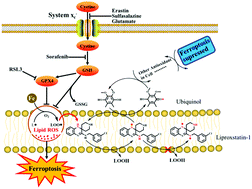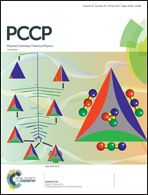Theoretical insights into the mechanism of ferroptosis suppression via inactivation of a lipid peroxide radical by liproxstatin-1†
Abstract
Ferroptosis is a recently discovered iron-dependent form of non-apoptotic cell death caused by the accumulation of membrane lipid peroxidation products, which is involved in various pathological conditions of the brain, kidney, liver and heart. A potent spiroquinoxalinamine derivative named liproxstatin-1 is discovered by high-throughput screening, which is able to suppress ferroptosis via lipid peroxide scavenging in vivo. Thus, molecular simulations, density functional theory (DFT) and variational transition-state theory with a small-curvature tunneling (SCT) coefficient are utilized to elucidate the detailed mechanisms of inactivation of a lipid peroxide radical by liproxstatin-1. H-atom abstracted from liproxstatin-1 by a CH3OO˙ radical occurs preferentially at the aromatic amine site (1′-NH) under thermodynamic and frontier molecular orbital analysis. The value of a calculated rate constant at 300 K is up to 6.38 × 103 M−1 S−1, indicating that the quantum tunneling effect is responsible for making a free radical trapping reaction more efficient by liproxstatin-1. The production of a liproxstatin-1 radical is easily regenerated to the active reduced form by ubiquinol in the body to avoid secondary damage by free radicals. A benzene ring and the higher HOMO energy are beneficial to enhance the lipid radical scavenging activity based on the structure–activity relationship study. Overall, the present results provide theoretical insights into the exploration of novel ferroptosis inhibitors.



 Please wait while we load your content...
Please wait while we load your content...